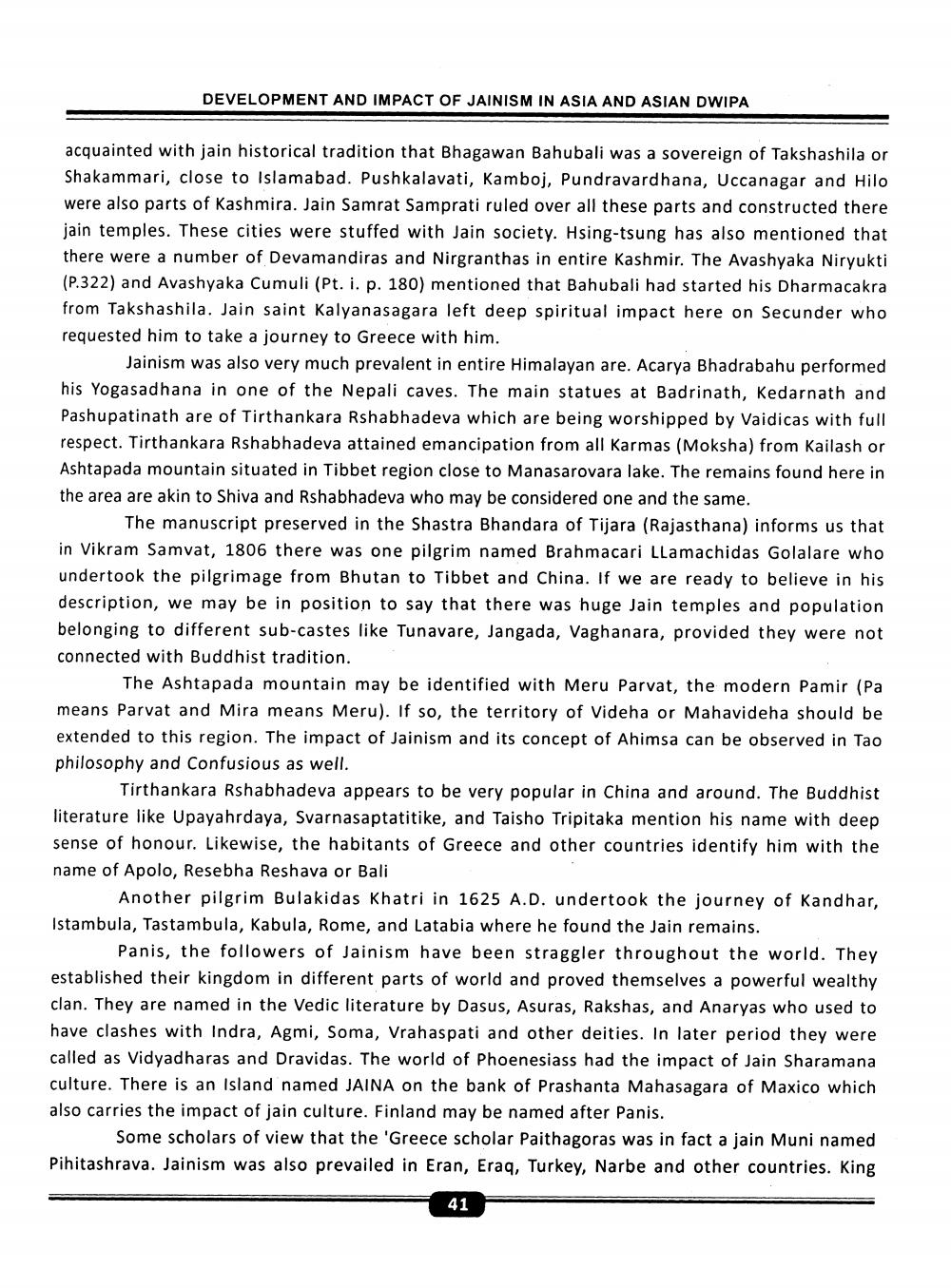________________
DEVELOPMENT AND IMPACT OF JAINISM IN ASIA AND ASIAN DWIPA
acquainted with jain historical tradition that Bhagawan Bahubali was a sovereign of Takshashila or Shakammari, close to Islamabad. Pushkalavati, Kamboj, Pundravardhana, Uccanagar and Hilo were also parts of Kashmira. Jain Samrat Samprati ruled over all these parts and constructed there jain temples. These cities were stuffed with Jain society. Hsing-tsung has also mentioned that there were a number of Devamandiras and Nirgranthas in entire Kashmir. The Avashyaka Niryukti (P.322) and Avashyaka Cumuli (Pt. i. p. 180) mentioned that Bahubali had started his Dharmacakra from Takshashila. Jain saint Kalyanasagara left deep spiritual impact here on Secunder who requested him to take a journey to Greece with him.
Jainism was also very much prevalent in entire Himalayan are. Acarya Bhadrabahu performed his Yogasadhana in one of the Nepali caves. The main statues at Badrinath, Kedarnath and Pashupatinath are of Tirthankara Rshabhadeva which are being worshipped by Vaidicas with full respect. Tirthankara Rshabhadeva attained emancipation from all Karmas (Moksha) from Kailash or Ashtapada mountain situated in Tibbet region close to Manasarovara lake. The remains found here in the area are akin to Shiva and Rshabhadeva who may be considered one and the same.
The manuscript preserved in the Shastra Bhandara of Tijara (Rajasthana) informs us that in Vikram Samvat, 1806 there was one pilgrim named Brahmacari LLamachidas Golalare who undertook the pilgrimage from Bhutan to Tibbet and China. If we are ready to believe in his description, we may be in position to say that there was huge Jain temples and population belonging to different sub-castes like Tunavare, Jangada, Vaghanara, provided they were not connected with Buddhist tradition.
The Ashtapada mountain may be identified with Meru Parvat, the modern Pamir (Pa means Parvat and Mira means Meru). If so, the territory of Videha or Mahavideha should be extended to this region. The impact of Jainism and its concept of Ahimsa can be observed in Tao philosophy and Confusious as well.
Tirthankara Rshabhadeva appears to be very popular in China and around. The Buddhist literature like Upayahrdaya, Svarnasaptatitike, and Taisho Tripitaka mention his name with deep sense of honour. Likewise, the habitants of Greece and other countries identify him with the name of Apolo, Resebha Reshava or Bali
Another pilgrim Bulakidas Khatri in 1625 A.D. undertook the journey of Kandhar, Istambula, Tastambula, Kabula, Rome, and Latabia where he found the Jain remains.
Panis, the followers of Jainism have been straggler throughout the world. They established their kingdom in different parts of world and proved themselves a powerful wealthy clan. They are named in the Vedic literature by Dasus, Asuras, Rakshas, and Anaryas who used to have clashes with Indra, Agmi, Soma, Vrahaspati and other deities. In later period they were called as Vidyadharas and Dravidas. The world of Phoenesiass had the impact of Jain Sharamana culture. There is an Island named JAINA on the bank of Prashanta Mahasagara of Maxico which also carries the impact of jain culture. Finland may be named after Panis.
Some scholars of view that the 'Greece scholar Paithagoras was in fact a jain Muni named Pihitashrava. Jainism was also prevailed in Eran, Eraq, Turkey, Narbe and other countries. King
41




